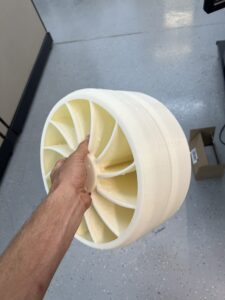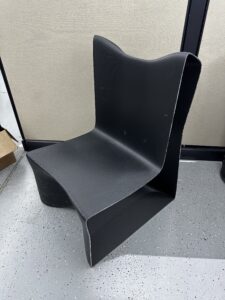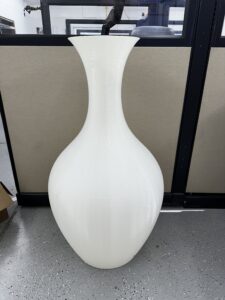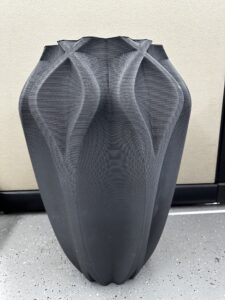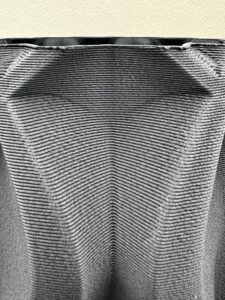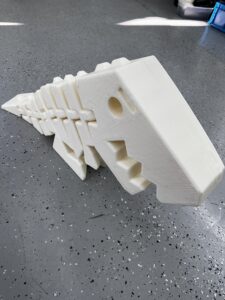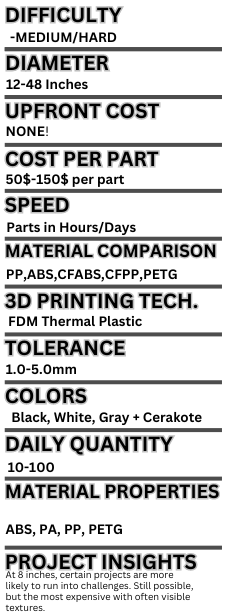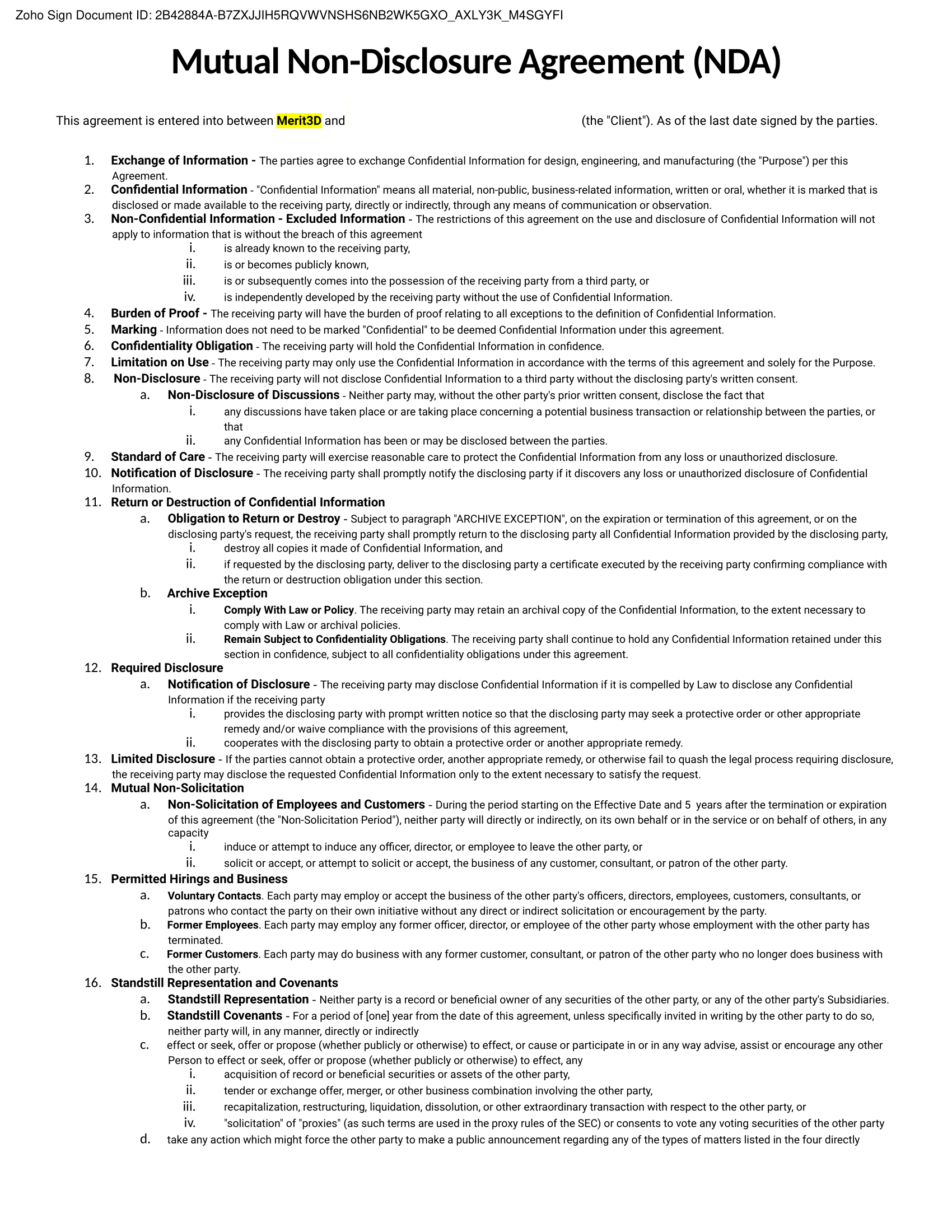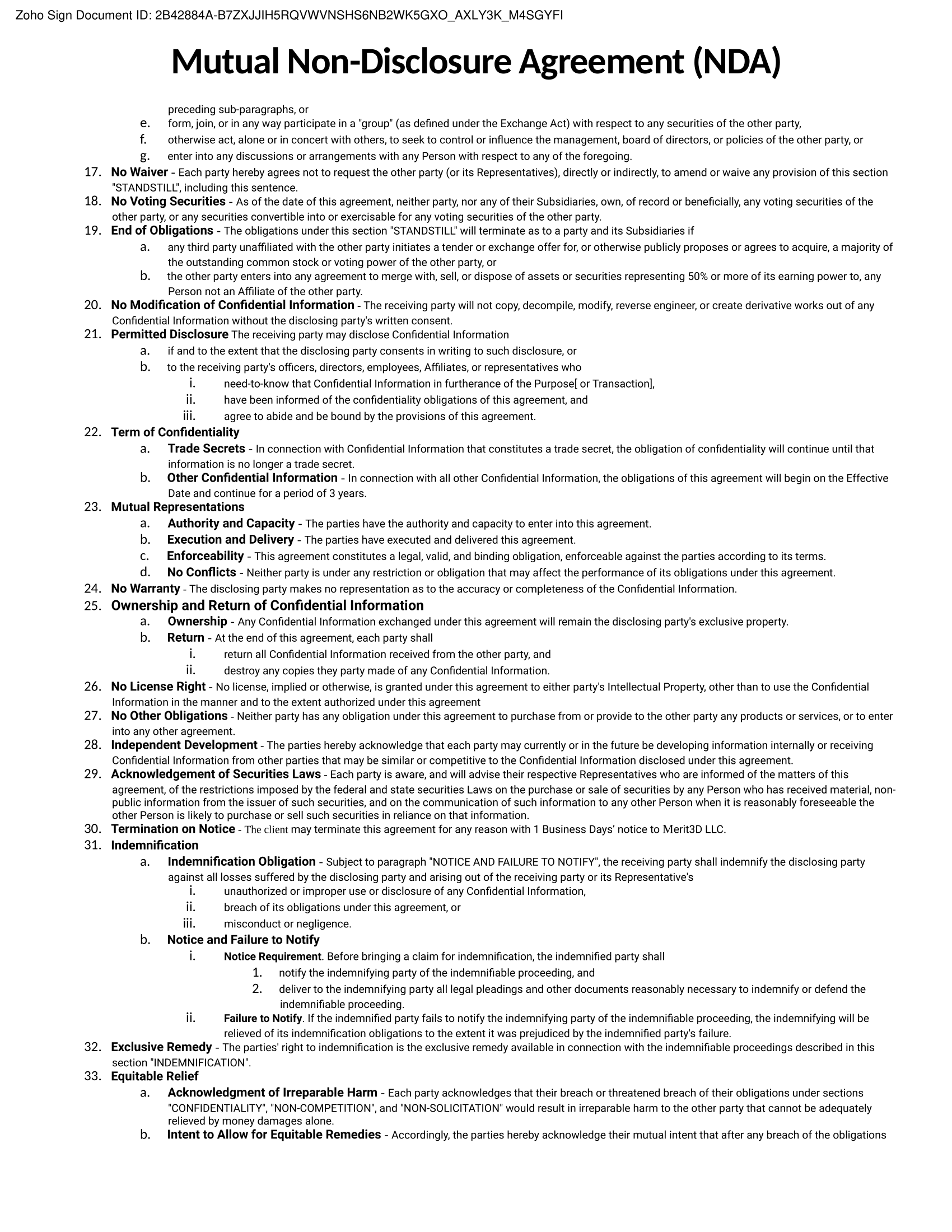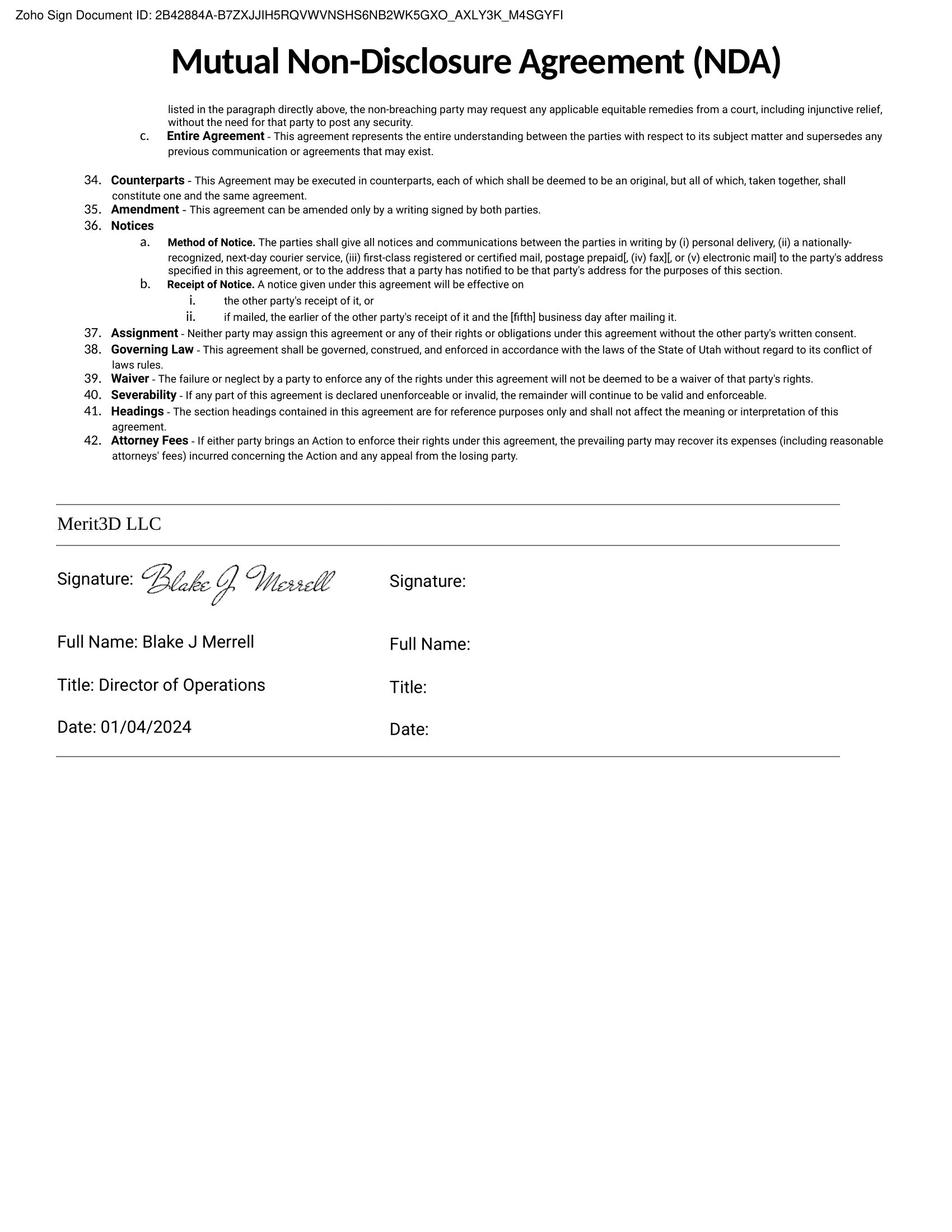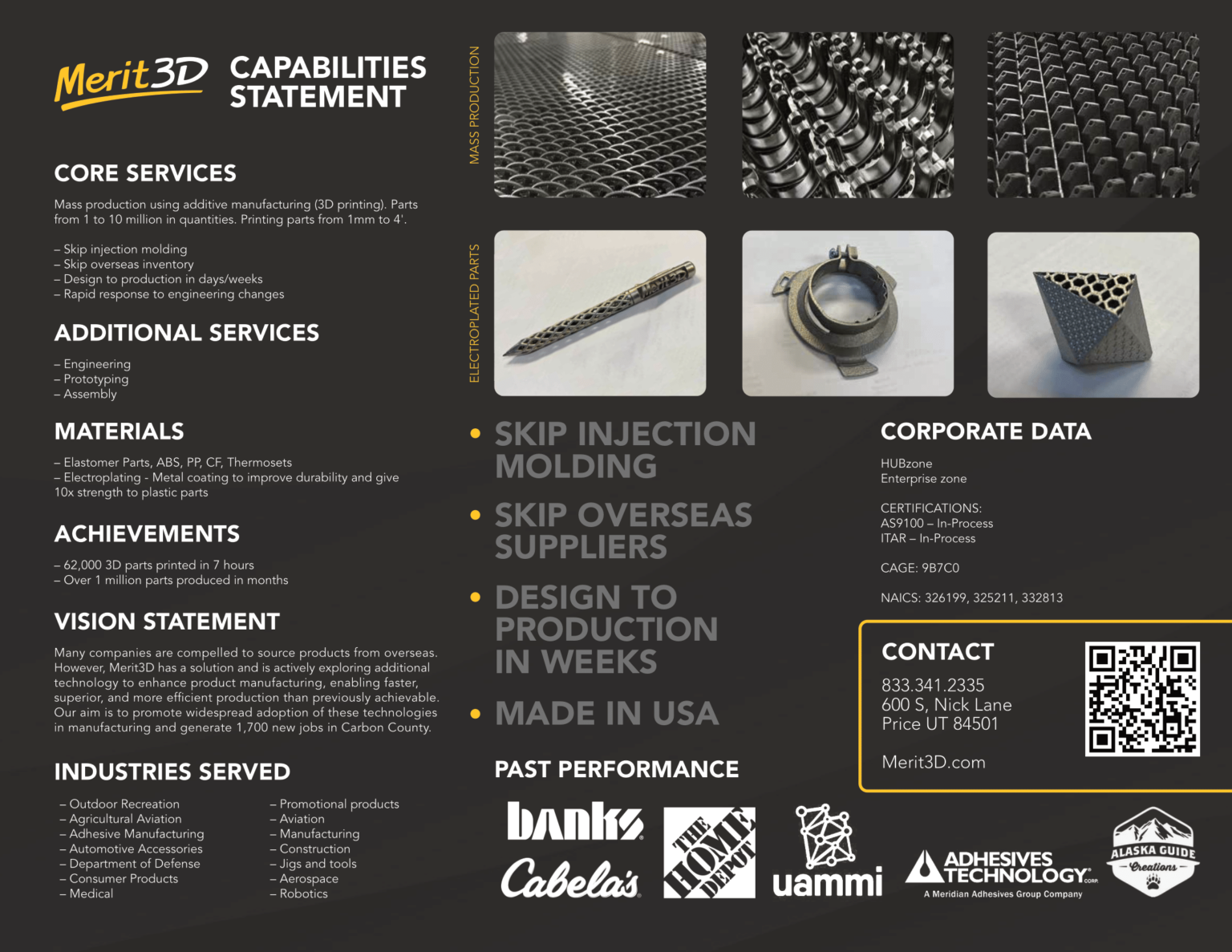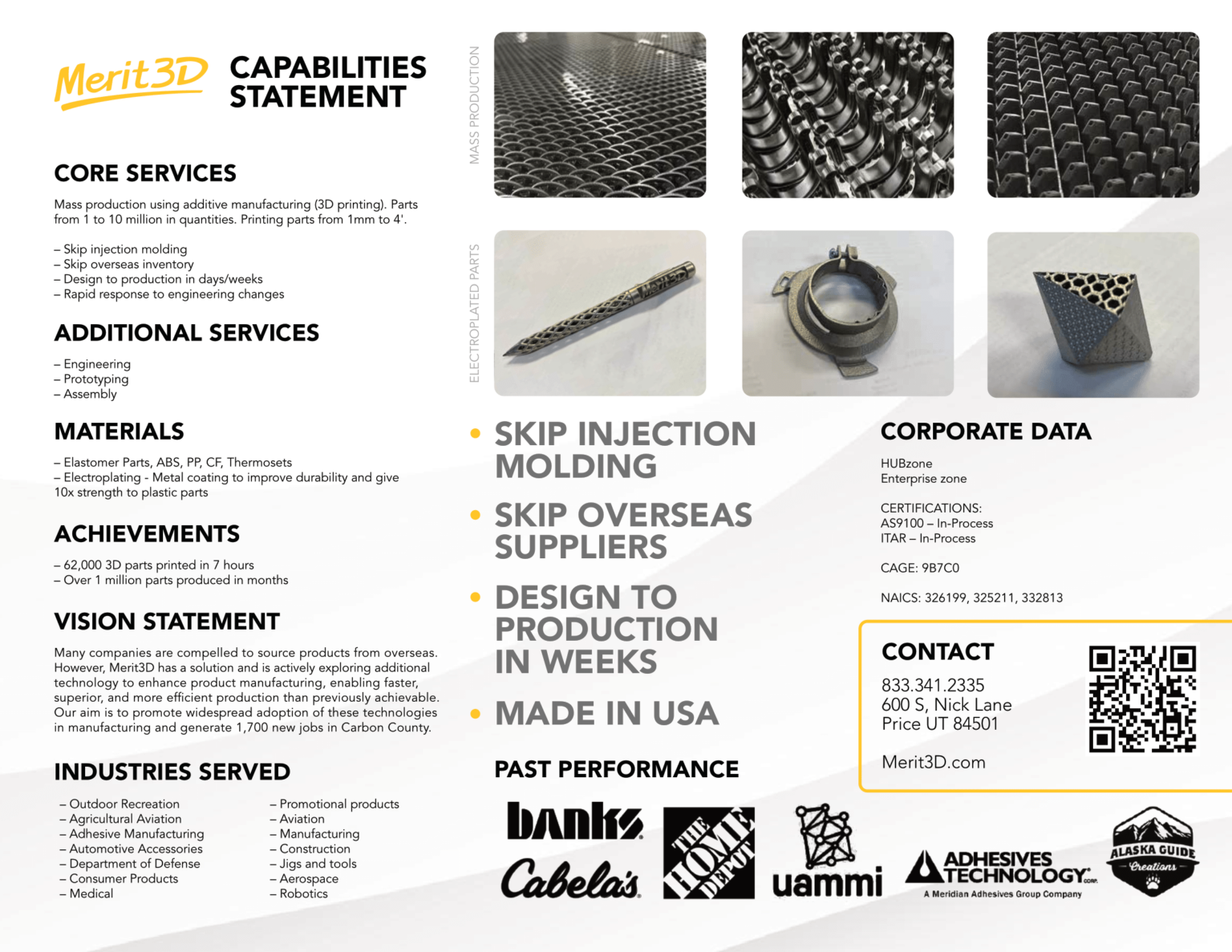Capabilites
"The best way to predict the future is to create it."
-Abraham Lincoln
We are creating manufacturing happiness... In 3D.
Part Categories!
Check out the short videos for quick info!
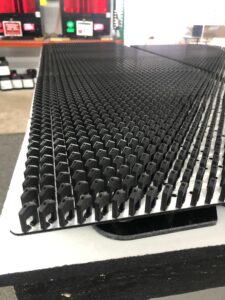
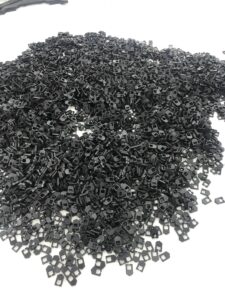
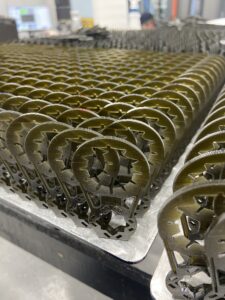
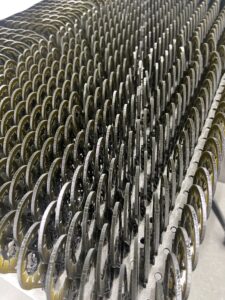
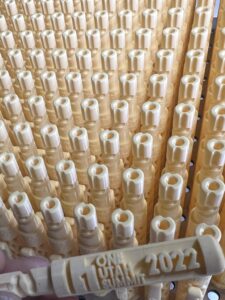
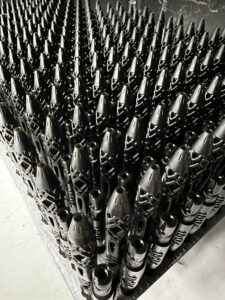
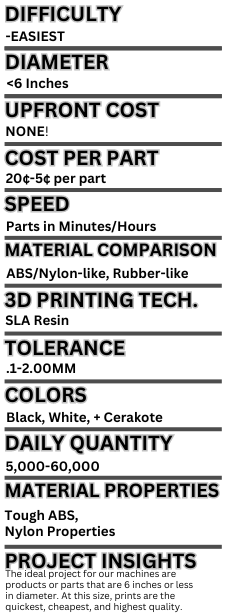
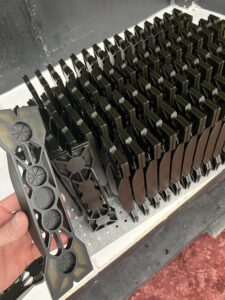
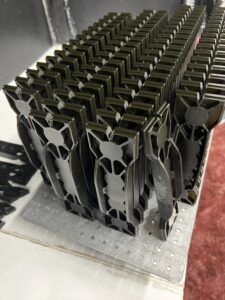
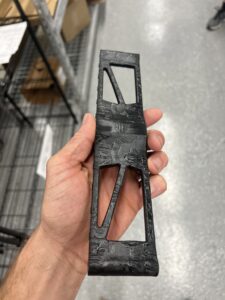
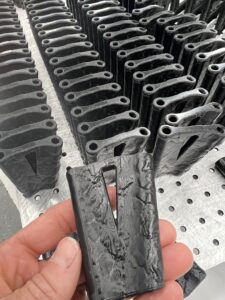
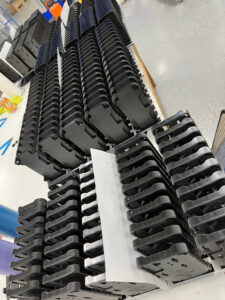
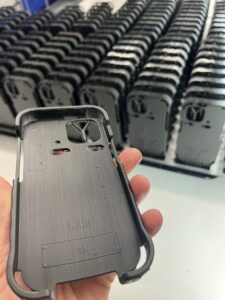
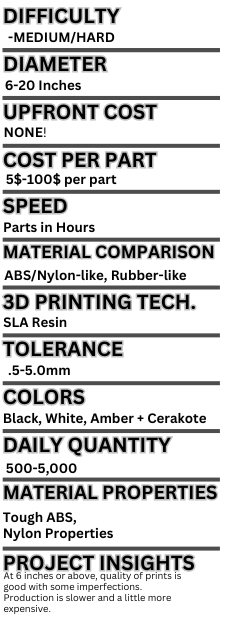
Small Parts!
Ease of Printing
These parts are the easiest and the cheapest to make. We can print thousands of parts like this per day. We have printed up to 62,700 parts in 7 hours and can print up to 100,000 in a 24 hr day.
Case Study AGC Binocular Tethers!
- Ultimately, the level of ease is completely dependant on your product variables, essentially product design, such as size, quantity (it takes as much time to set up a print of 100 and a print of 10), and if supports are required.
Cost
These are the parts that compete closely with injection molded piece prices. With no set minimum order quantity and no mold required, 3d printed parts of this size are the bread and butter of Additive Manufacturing in mass.
- The cost of each product varies based on a number of factors, though the most impactful source on pricing is how much resin your part uses. The more resin needed, the higher the cost.
Colors
We currently produce parts mainly using a black material. There are also a white and amber variant.
Case Study of Promotional Pens!
We also have Ceramic Coatings coming soon!
Tolerances
This is different for every project. We can mass produce in quality as fine as 50 microns per layer, though 250 is our most common quality. For projects requiring finer quality and or tighter tolerances, 100 microns is our common layer height.
Case Study of Miniatures printed at 50 Microns!
Capacity
The most parts we have printed is 62,700 in 7 hours, with the capability to produce up to 100,000 of them in 24 hours. We delivered the 60,000 part order by hand the same day. The Photocentric Magna printers we operate run through mass production orders. With Merit3D holding the world record for both the most 3d printed parts in one day, and the largest order of 3d printed parts in history, at 1 million.
Case Study of the 62,700 part production!
Case Study of the 1,000,000 part order!
Materials
We offer a variety of materials for production! With our most commonly used being DL110HB. We use tough-durable parts that compare to injection molded materials. With the quality and strength of our materials, we’ve already begun reshoring manufacturing and our customers love the materials!
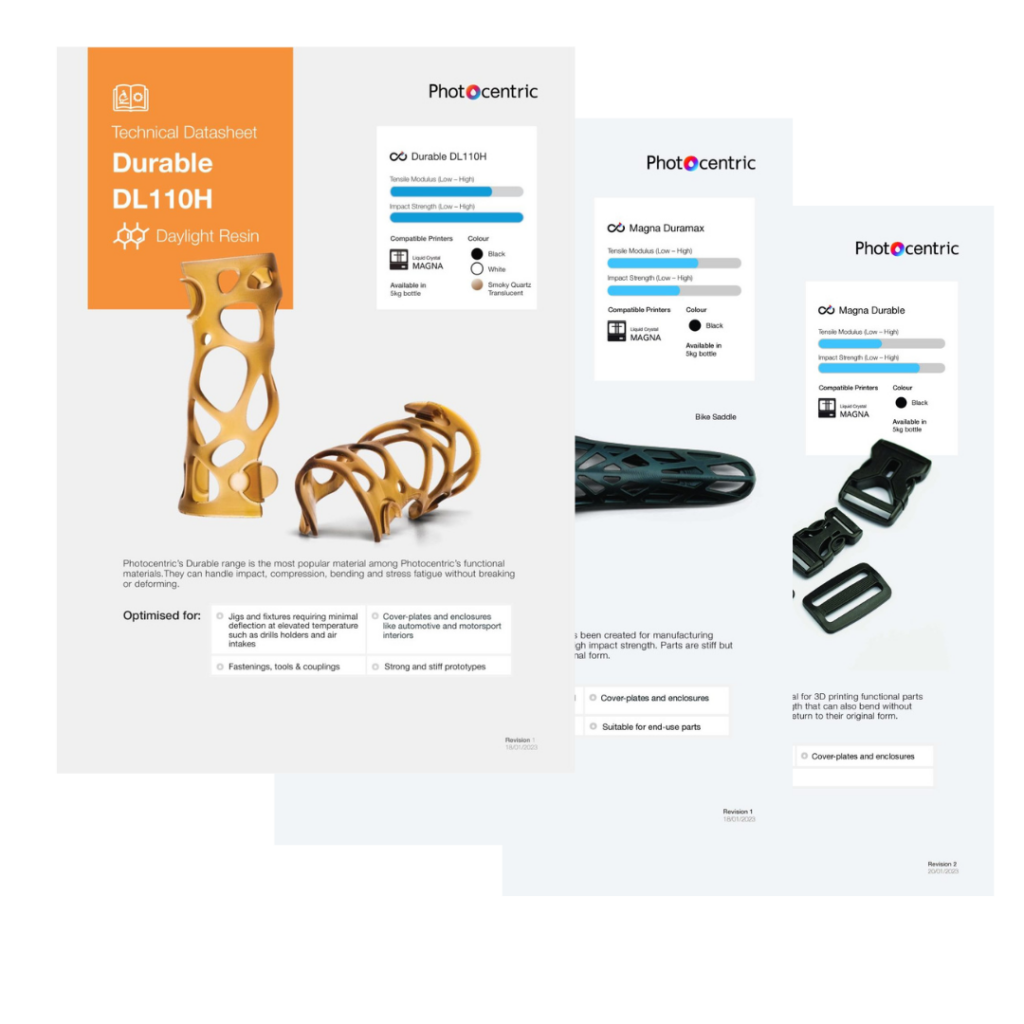
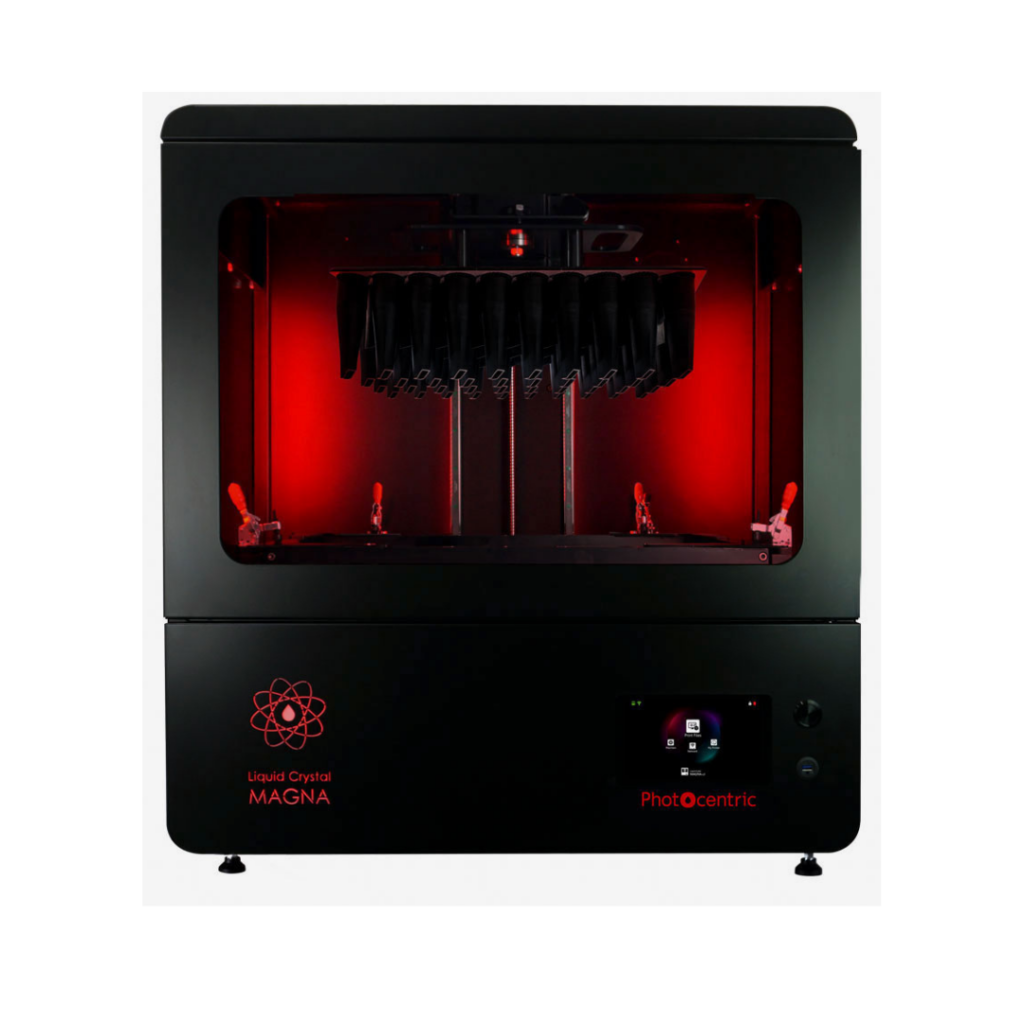
Medium Parts!
Ease of Printing
These parts are generally easy, though can sometimes be difficult. The cost is higher than the smaller parts because of the size difference and challenge to produce. We can print hundreds to thousands of parts like this per day. We have printed over 32,600 phone cases for PhoneSkope.
Link to the PhoneSkope Gallery Info!
- Ultimately, the level of ease is completely dependant on your product variables, such as size, quantity (it takes as much time to set up a print of 100 and a print of 10), and if supports are required.
Cost
These are higher priced because of the volume of the resin used, and the amount we can fit on a build plate. With no set minimum order quantity, very large production runs usually have very competitive pricing, though with smaller orders the pricing is higher.
- The cost of each product varies based on a number of factors, though the most impactful source on pricing is how much resin your part uses. The more resin needed, the higher the cost. These parts will use double or more the resin than the small parts, effectively doubling the price.
Colors
We currently produce parts mainly using a black material. There are also a white and amber variant. We also offer the option to cerakote the parts in many more colors! The size of the parts, now being medium, does not affect the color options!
Case Study of pens Cerakoted and bare!
- Cerakoting is a specialized ceramic-based coating process that enhances the durability, corrosion resistance, and aesthetics of various surfaces. It involves applying a thin layer of ceramic material through a spray gun, which is then cured at high temperatures, creating a protective and visually appealing finish.
Tolerances
This is different for every project. We can mass produce in quality as fine as 50 microns per layer, though 250 is our most common quality. For projects larger than 6 inches, 250 microns is our common layer height.
Case Study of Miniatures printed at 50 Microns!
Capacity
We have printed over 32,600 PhoneSkope cases, and a countless amount of other parts for various customers for parts of this size. Medium sized parts cannot be produced as quickly as the small parts, though the speed of production is still weeks to months faster than ordering overseas.
Link to Gallery info of PhoneSkope cases!
Materials
The materials used for medium sized parts are the same! Both the small and medium sized parts use the materials listed on our materials page!
Machines
The Machines used for medium sized parts are the same! Both the small and medium sized parts are printed on the same printers!
Large Parts!
Ease of Printing
The manufacturing method changes from LCD SLA to FDM. These parts are usually more difficult, though can sometimes be simple. The cost is higher than the medium parts because of the size difference and manufacturing method. We can parts up to approx 3m cubed.
Link to the Caracol AM Heron 300 Printer!
Link to the EXT 1070 Titan Printer!
- Parts on this size can no longer be estimated using our instant estimate tool. The FDM method has a wide variety of materials and it’s own set of unique challenges for parts this large. A print that works on the Ender 3 or any other small FDM will not be interchangable without a custom design process for each part.
Cost
These are higher priced based of the volume of the material used, the type of material required, and the design-support process. With no guide book to all the right answers, each part must be carefully processed to plan and execute a successful print.
- The cost is higher because of how much pre-production that’s required, as well as some material types being very expensive. (Such as carbon fiber infused…) Warping is a issue in taller prints due to uneven cooling. Layer lines are more visible on large prints, affecting looks. Designing these prints takes a lot of time and careful planning. Large prints often need many support structures, increasing material use and post-processing time. These factors make large-scale FDM printing complex and lengthy.
Colors
The color options for FDM prints of this size vary based on which FDM, and the material required for each part. Though painting parts produced out of nearly any FDM material will be viable and effective solution, should there be no material option already that color.
Link to the EXT 1070 Titan Materials!
Link to the Caracol AM Heron 300 Materials!
- Cerakoting is a specialized ceramic-based coating process that enhances the durability, corrosion resistance, and aesthetics of various surfaces. It involves applying a thin layer of ceramic material through a spray gun, which is then cured at high temperatures, creating a protective and visually appealing finish.
Tolerances
This is different for every project. The FDM machines have a variety of different nozzle sizes. The Titan has a .6mm nozzle, up to 9mm. The Caracol Printer has a 1-7mm nozzle.
Link to the EXT 1070 Titan Spec sheets!
Link to Caracol AM Heron 300 Spec Sheet!
Capacity
The printing capacity of prints done the FDM printers are the most heavily dependant on the part size and amount of current customers. With most prints done on these being very large, the print time can take 10+ hours without even approaching the maximum build height possible. For more information on capacity regarding the FDM printers, contact us!
Materials
Generally, our FDM printers can use, PP, ABS, CFABS, CFPP, PETG, and other common thermal plastics.
For materials used to produce large parts via FDM, see the printer manufacturer’s website for specifics.
Machines
The Machines used for large parts are the EXT 1070 Titan, and the Caracol AM Heron 300!
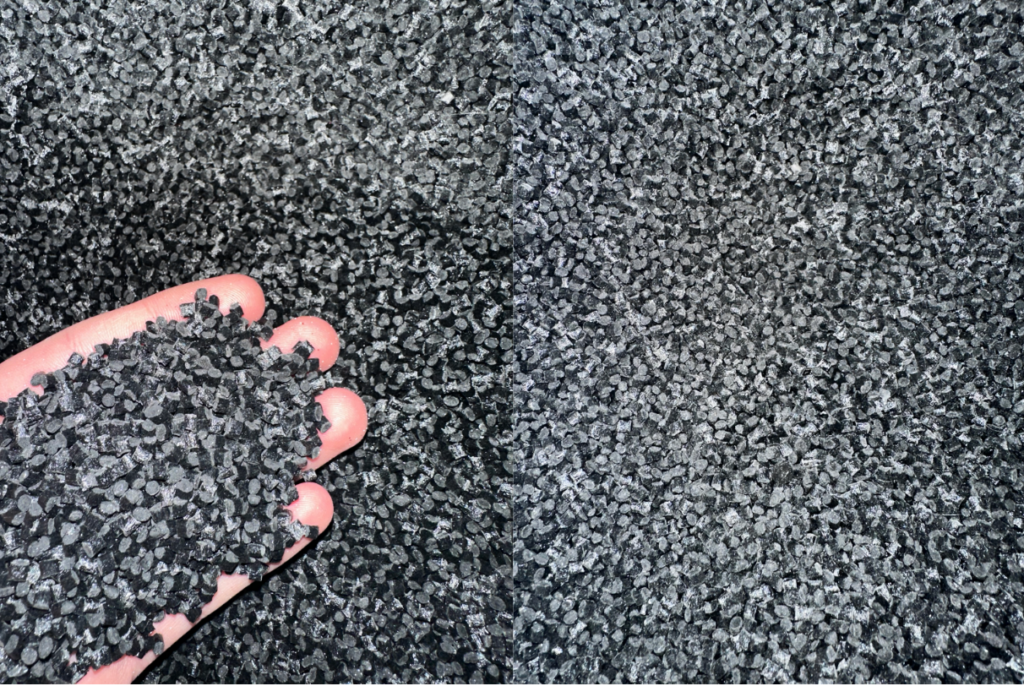
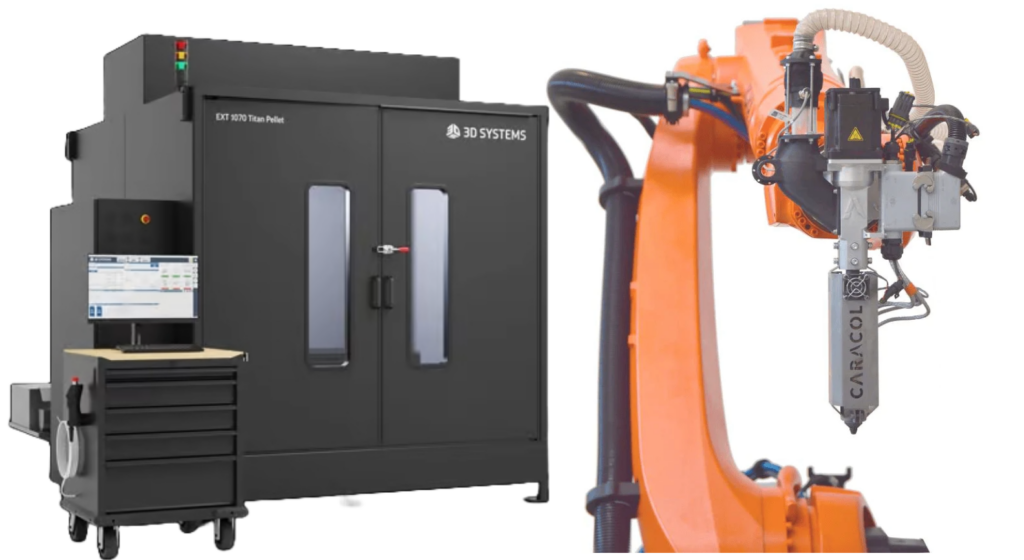
Certifications!
ITAR (International Traffic in Arms Regulations) Certification Overview
Coming 2024!
This video explains how we, Merit3D, use resin 3d printers to mass manufacture parts.
Videos!
Discover the fascinating world of additive manufacturing and explore how it outpaces traditional injection molding in terms of speed and efficiency! In this video, we delve into the innovative realm of 3D printing, showcasing its ability to revolutionize production timelines and streamline the manufacturing process.
This is a short and simple video explaining what the resin 3d printing process is.
Need help? We're here.
Are you ready to get started now? Get a quote, or reach out to us with your questions.

